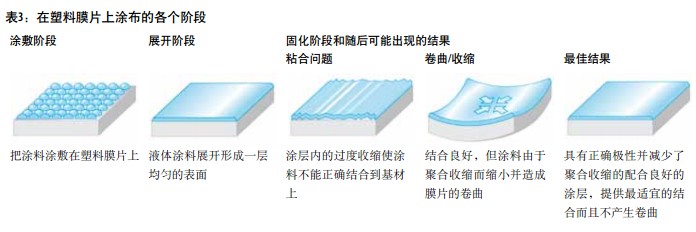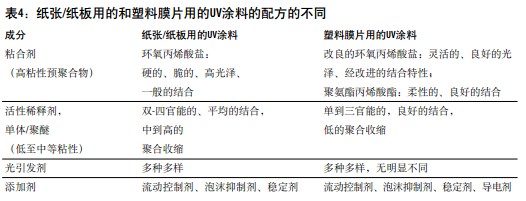Except for the fact that UV gloss coatings require some time to unfold before applying UV radiation, the curing mechanism for UV inks and UV coatings will remain essentially the same. It should be noted that compared with paper or cardboard substrates, plastic substrates have different habits. This article from paint supplier ACTEGATerra describes some special considerations.
UV radiation method
Learning curing is one of the most innovative technologies for drying inks and coatings in the printing industry. With the help of UV technology, it can also print on a variety of non-absorbent substrates. The initial application in the early 1970s has fully utilized the same process advantages that are still valid today (Table 1). During this period, in the field of narrow web printing, UV curing has occupied more than 90% of the share. UV systems are also becoming more and more popular among packaging printers. In this industry, sheet-fed offset printing is increasingly becoming the process of choice for printing and glazing.

The in-depth and meticulous research and development of raw materials, inks and coatings have further promoted the wide application of this technology in many fields of modern printing industry and plastic film printing. However, when compared to paper and paperboard applications, if coatings are to be applied to the plastic film, there are a variety of special considerations (Table 2).

Diaphragm thermal sensitivity
UV lamps also emit a certain amount of infrared radiation (ie heat). This heat will of course support the curing process, but if overheated it can easily lead to curling of the printed sheet. The problems caused are reduced registration accuracy and undesirable stack temperature increases. It is therefore important to use only the actual required amount of UV radiation to cure the applied ink and coating. Modifications to process parameters can help eliminate unnecessary heat input.
Generally, UV curing will be carried out under the influence of ambient air. However, since the oxygen molecules in the air also strive to react with the ink or paint components, it is necessary to increase the lamp power to compensate for this competitive reaction, which naturally puts an unwanted thermal load on On the substrate. A long-established technology used in web feed applications-inert UV technology, can also immediately provide a solution for sheet-fed offset printing. In this way, the gap between the UV lamp and the substrate is filled with nitrogen to replace the parasitic oxygen to make it inert. A competitive reaction with oxygen in the atmosphere is prevented, so that the power of the lamp can be significantly reduced and therefore the amount of heat transferred into the substrate. Another advantage of doing this is to reduce the amount of photoinitiator required for UV inks and coatings, which is a prerequisite for low-odor UV systems.
Combination of paint and substrate
Various factors determine the combination with the plastic substrate. Since this bonding is actually always a mechanical adhesion process, surface tension plays an important role. In order to achieve a good combination of ink or coating, the surface tension of polyolefin substrates, such as polypropylene (PP) and polyethylene (PE) membranes, should be at least 38 mN / m, and preferably 40 mN / m Meter. In most cases, the surface of the diaphragm has been corona treated by various suppliers.
However, we recommend that you still check the surface tension before use, because the positive effect of the pretreatment will decrease over time, and it will fail after a maximum of six months, and this often happens a lot in advance (test For details of the method, see the article on surface tension). If the measured surface tension is too low, the tension can be increased again by corona treatment immediately before printing. Especially for PP and PE, this has been shown to be a very convenient measure. On the other hand, corona treatment is not always necessary for PVC, PET, and PS substrates, but when adhesion problems are encountered, the usefulness of this treatment can still prove. KBA will provide a corona module for online pretreatment in front of the first printing unit.
Substrate curl after printing and polishing
Heat input is not the only factor that can cause the substrate to curl. The so-called polymerization shrinkage produces the same effect. The curing of UV inks and coatings reduces their volume by 2-10%, depending on the quality of the individual product. This also causes the surface area of ​​the ink or paint film to shrink, thereby causing the plastic film to curl.
A method of choosing a non-shrinking UV coating can be used to reduce this consequence or at least have a significant impact on it. It is also important to ensure that the paint is not applied beyond the necessary thickness.
Static electricity generation and glass plate effect
All plastic diaphragms, whether in strip or sheet form, are usually highly susceptible to static electricity. If it is in the form of a single sheet, this will cause the problem of poor membrane separation in the feeder of the printing machine and subsequent processing in the downstream. In addition to installing static elimination systems on printing and finishing machines (see Kersten's article on static elimination systems), proper storage can also reduce the generation of static electricity. In order to adapt to the environment correctly, the film should be kept between 20 ° C and 22 ° C and the relative humidity at 55% during the three days before printing.
Especially when processing very thin membranes, it can almost be concluded that poor separation of the membrane after printing will occur. For this reason, the use of a paint with a conductive agent composition may help to avoid the so-called "glass plate effect", that is, the mutual attraction between the single diaphragms because the air between the diaphragms is very smooth. The phenomenon that the polished surface is forcibly discharged and enhanced.
Coating for plastic film in single offset printing
For best results, the formulation of raw materials for UV coatings used in plastic films is different from the formulation of UV coatings used in paper and cardboard. Therefore, the UV film coating has very good adhesion characteristics, and the flexibility of the final coating on a single film is enhanced.

In addition to the standard high-gloss and matte gloss coating types, it can also provide various gold and silver effects, pearlescent finishes and various levels of opaque white for plastic diaphragms. UV film coatings can also be customized to provide specific functions, such as chemical resistance to most solvents, acids and alkali metals. In addition, special formulations can affect the mechanical properties of the results. Can get excellent friction resistance and friction value in the entire range from non-slip to immediate release effect. More options are heat-resistant UV coatings for in-mold labels, or UV systems with low odor and low migration for food packaging.
The printing and coating of plastic substrates will place special requirements on all aspects of processing, including printer manufacturers, suppliers of diaphragms, inks and coatings, and printing workers at the end of the chain but not the least important . Therefore, users must communicate frequently with all collaborators, because only in this way can you truly become a successful competitor in this interesting and innovative market field.
Aluminum Saucepan,Aluminum Sauce Pan,Best Aluminum Cookware,Aluminum Pots And Pans
SUZHOU JIAYI KITCHENWARE TECHNOLOGY CO.,LTD , https://www.jiayikitchenware.com